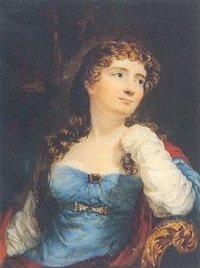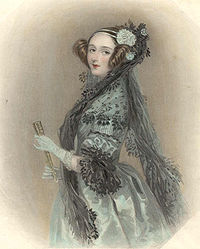Lady Byron
Monday, January 12th, 2009A Quiet Adjustment, Benjamin Markovits, 2008
This historical novel features Anne Isabella Milbanke, an only child known as Annabella, who married the great and already famous poet and romantic Lord Byron, with whom she gave birth to their only child, a daughter, Ada Lovelace, famous today as the first computer programmer (of Charles Babbage’s early mechanical general-purpose computer, the analytical engine).
Lord Byron 1788-1824  Lady Byron 1792-1860
Lady Byron 1792-1860 
One book blurb call the novel “as finely textured, nuanced, and vivid as Balzac, but for this reader, Markovits, a young American living in London, seems more likely to be channeling Henry James who, unlike Balzac, lived almost 100 years after the time of Lord Byron. I don’t mean this in a disparaging or condescending way, (although many contemporary novelists do seem intent on trying to imitate James) but with real sincere admiration for the style. Humor shines through very subtle, dry wit, as Milbanke describes Annabella’s feelings and reactions, even when she spends time contemplating the message a particular manner of dress will carry. Missing is the usual feeling one gets with James’ imitators that you just wish they would get on with it.
Annabella’s situation and life is at the same time sad, poignant, and yet somehow humorous. She spends more than one season in London turning down at least five different suitors. She has set her sites on the famous genius Lord Byron, who is well understood to be having a shocking affair with Annabella’s married cousin Lady Caroline Lamb, but when Bryon finally makes his overture to Annabella, her independence comes rushing to the fore as a matter of habit, and she turns him down as well. She retires to the countryside to begin her spinsterhood.
Two years later Lord Byron tries again and this time Annabella accepts. Once they are married Byron tells her that if she had married him two years earlier she might have saved him but now it is too late. Annabella doesn’t know what he is talking about. The strange young man that Byron brings to her wedding should have given her a hint but she is extremely innocent for all her intelligence and wit.
Milbanke writes of their honeymoon “It seemed a measure of her unhappiness that she often looked forward to the violence of his desires as a respite from the indifference of his larger neglect.” Their lovemaking, which Annabella refers to as ‘getting greedy’, even takes place on a discovered billiard table. When drunken Byron discharges a gun into a mirror and the splintered glass cuts his wife, Annabella’s large maid becomes so alarmed that the she attempts to separate the pair from fear for her mistress’ life.
Annabella attempts to befriend Byron’s close married half-sister Augusta (Gus) Leigh in an attempt to control Byron but then becomes suspicious that Gus and Byron are having an incestuous affair. Byron dotes on Gus’s daughter Elizabeth Medora Leigh born only one year before the Byrons’ only child Ada.
When the bailiffs arrive and take up residence at the Byrons’, Annabella takes baby Ada and runs away back to her parents. In proof that some things never change, Annabella’s father retains a lawyer to sue for separation, even though Annabella may want a reconciliation.
Annabella just managed a joke about having lately acquired, in addition to hunger and thirst, a third appetite for legal matters.
Annabella approaches cousin and former Byron lover Lady Caroline who tries to shock Annabella with tales of Byron’s incest with sister Gus and his wild homosexual experiments at school and in Turkey.
There was a pause; and Annabella felt obliged, for the sake of her own pretended innocence, to fill it with a suitable measure of Horror. Just what that measure should be, it struck her for the first time (with a real shiver of the real thing), she was no longer in fact innocent enough to gauge; but she wished, in any case, to make a display of repugnance that would still give a point to what was really her larger experience of her husband’s delinquencies.
Annabella conspires with her social connections to force a confession from Gus as the price of Gus’s continued social acceptance. Finally a letter from Byron to Gus expressing the wish that they had remained single because they were the only two capable of loving one another or at least had become monk and nun, Annabella has to be satisfied. Annabella and Gus become an odd couple for the remainder of Byron’s life and exile. Byron leaves behind a revealing and frank memoir and it is up to the two women to decide the fate of the memoir. Typically Annabella asserts “I can myself give no appearance of approval to any kind of suppression.” It is left to Gus, who has perhaps the most to lose, to suppress it. The memoir is burned.
Ada never really spent any time with her father Byron and only learned of his death later. Ada asks her mother on the death of Annabella’s father: “Why have you a father when I have none? Have you given me yours?”
Long Postscript: By 1970 the two dominant computer languages FORTRAN and COBOL were understood to be inadequate for the needs of modern programming. PASCAL was developed in 1970, intended to teach structured programming in schools, but it was soon widely employed for commercial work as well.
In 1972 Dennis Ritchie of Bell Labs introduced the language “C” and the Labs immediately implemented the UNIX operating system in C. UNIX, noted for its compactness and stability, became the dominant platform for engineering workstations and later for Internet servers.
A battle resembling nothing as much as a religious war broke out between programmers advocating Pascal and those advocating C. C won, primarily because of its simplicity and powerful generality (particularly its use of referencing and de-referencing variables which meant that C was able to directly address hardware registers without resort to machine language), in other words, C was totally general.
C was adopted for commercial work by virtually every major company including Apple and Microsoft (Microsoft’s first C compiler required three distinct passes and was a nightmare to use; one of the only dark spots in the otherwise bright history of C). C was absolutely stable until windows implementations showed the value of and need for object encapsulation which was added to C in the form of the super set C++. Both the windows interface and object encapsulation came out of research at Xerox Parc in the mid 1970s.
C++ was immediately and universally adopted for commercial work. The Internet protocols (TCP/IP) were implemented in C (under a Defense Advanced Research Project Administration DARPA grant; i.e. with DOD money); windows (both Apple and Microsoft) were implemented in C and C++ and Internet browsers, built for the windows user interface, starting with the U of Illinois’ Mosaic (father of Netscape and grandfather of Firefox; Internet Explorer is a faulty ripoff.) were implemented in C and C++.
Simultaneously with all this activity, the Department of Defense (DOD), from 1978-1980, sponsored its own effort to create a new language, inviting academic scholars to make their contributions. The resulting language was named in honor of Ada Lovelace on her birthday in 1980.
Ada is everything you would expect from a large committee of academics sponsored by the DOD; the language was huge, ambiguous, complicated, and virtually impossible either to program or implement in a compiler. Because different compilers interpreted the language differently, a program written in Ada was likely to create different results on different machines. The language was so vast, a solution to the same problem written by two different programmers might use completely different subsets of the language, looking like they had been implemented in different languages. Virtually no programmer is able to become proficient in the entire Ada language, which continues to evolve and grow, becoming ever more complicated right to this day (objects were added in 1995 and the latest version was released in 2007).
The DOD then insisted that all defense systems be written in their new language with two dramatic consequences. DOD software continues to be a nightmare of bugs nearly impossible to understand or maintain; and computer professionals were separated, early in their careers into commercial or defense work. It was and remains virtually impossible for programmers to move from one world to the other even though the DOD has been forced to adopt the Internet and its tools and languages for much of their work today.
Ada has had an enormously negative impact on military systems but fortunately its use was limited to DOD applications and never entered the commercial world in any serious way. It’s a shame Ada Lovelace, as the first programmer, couldn’t have been honored with C instead.
